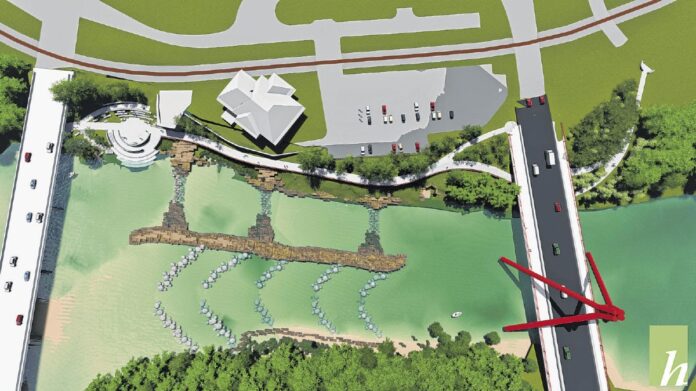
The city of Columbus is preparing an application for the proposed riverfront redevelopment, planning to submit it to the Indiana Department of Natural Resources by the end of October.
Redevelopment director Heather Pope said the city is awaiting a response to its jurisdictional determination from the Army Corp of Engineers. The Army Corp of Engineers is studying the area between the Robert N. Stewart Bridge and the Third Street bridge where the city has proposed an $8.6 million riverfront project.
Pope said the response from the Army Corp of Engineers is expected in October and must be included in the city’s application to DNR.
A jurisdictional determination by the Army Corp of Engineers must be completed when proposing a project that would manipulate the United States’ jurisdictional waters, the waters that make up the country’s rivers, streams, lakes and oceans, said Jason Larrison, project manager.
[sc:text-divider text-divider-title=”Story continues below gallery” ]
“Anytime you manipulate the waters where you’re providing capacity or taking capacity away, it impacts the waterway up and down stream, which could cause issues like a loss of wetland habitats or flooding,” Larrison said.
The Army Corp of Engineers takes into consideration the project area, what is being proposed and the city’s own calculations of impact.
Larrison said he doesn’t expect the city will have to make many changes to its proposed project. If anything, he said the Army Corp of Engineers may ask that the design include more mitigation such as making up for the loss of trees.
Hitchcock Design Group is designing the Columbus Riverfront project, an $8.6 million conceptual plan calling for several overlooks of the East Fork White River downtown, connections to the People Trail system and an in-water recreation area.
The project is funded primarily through tax increment financing, or TIF funds, which are received on commercial and industrial properties within the TIF district, Pope said. The city has received a $100,000 grant from the Columbus Parks Foundation and is also seeking grants from the Heritage Fund and through Indiana’s Next Level Trails Grant program.
Randy Royer, lead designer with Hitchcock Design Group, unveiled a new model to the Columbus City Council in June for what the Riverfront would look like if all goes to plan.
The new design incorporates a fish passage channel and a rock arch ramp structure using natural materials, which reduces the amount of grout required in the structure, accommodates boat passage and maintains the river’s water level.
He also highlighted the project’s many design drivers, including the removal of the lowhead dam, access for safety personnel, maintenance and repair of the river banks, economic and workforce development, ecology, connections, compelling attractions and captivating appearance.
Removal of the low-head dam between Second and Third streets is Hitchcock’s number one priority, as it is for the city and DNR, Royer said. The low-head dam was originally installed a century ago to pool water near the former city pump house for the city’s water supply. The former city pump house has been renovated into the Upland Columbus Pump House brewpub.
[sc:pullout-title pullout-title=”Where to learn more” ][sc:pullout-text-begin]
To learn more about the Columbus Riverfront project, visit columbusriverfront.org. The website features a list of updates regarding the project and how the redevelopment will impact local residents and visitors for years to come.
[sc:pullout-text-end]




